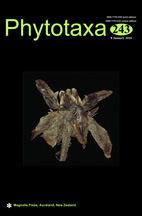Abstract
Chlorophytum heynei Baker (1876: 322) was described based on a collection of Rottler from India in 1816. This species is characterized by elliptic-obovate with pseudopetiolate (petiole 5–8 cm channeled), scape shorter than the leaves, absence of sterile bracts; greenish flowers, anthers shorter than the filaments and papillose filaments (Robi et al. 2015). Most of the recent literature (Sasidharan & Sivarajan 1996, Sivarajan & Mathew 1997, Sasidharan 2013) misidentified this species with C. palghatense K.M.P.Kumar & Adsul (Prabhu et al. 2014: 282), but Robi et al. (2015: 78) resolved the taxonomy of these names. Unaware of this work, plants of Chlorophytum (Ker Gawler 1808: 1071) were described as C. clivorum Mathew & George (2015: 379), based on collections in the mountain forests of Achankovil (part of Achankovil Shear Zone), in Kollam district of Kerala. The critical analysis of the type specimens and protologues associated with both names shows that both the names C. heynei and C. clivorum apply to the same biological unit. Hence, C. heynei holds nomenclatural priority (McNeill et al. 2012, Art. 11.4).

